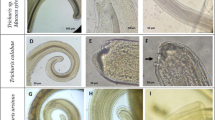Abstract
Whipworms were collected from rodents (Muridae) from six West African countries: Burkina-Faso, the Islamic Republic of Mauritania, and the Republics of Benin, Guinea, Mali and Senegal. Molecular sequences (ITS-1, 5.8S and ITS-2 of the ribosomal DNA gene) and morphometric characters were analysed in Trichuris (Nematoda: Trichuridae) specimens found in seven host species: Arvicanthis niloticus, Gerbilliscus gambianus, Gerbillus gerbillus, G. tarabuli, Mastomys erythroleucus, M. huberti and M. natalensis. Phylogenetic analyses revealed three clades, one recognised as Trichuris mastomysi, previously recorded in M. natalensis from Tanzania, and the other two previously undescribed. A new species named Trichuris duplantieri n. sp., found in Gerbillus spp. from Mauritania, was characterised using molecular and morphometric methods.



Similar content being viewed by others
References
Bernard J (1969) Quelques nématodes parasites nouveaux ou non encore signalés en Tunisie. Arch Institut Pasteur Tunis 46:397–411
Bernard J (1987) Faune des nematodes parasites des mammifères de Tunisie et des contrées voisines. Arch Institut Pasteur Tunis 64:265–319
Brouat C, Duplantier J-M (2007) Host habitat patchiness and the distance decay of similarity among gastro-intestinal nematode communities in two species of Mastomys (southeastern Senegal). Oecologia 152:715–720. doi:10.1007/s00442-007-0680-8
Callejón R, De Rojas M, Feliú C et al (2012) Phylogeography of Trichuris populations isolated from different Cricetidae rodents. Parasitology 139:1795–1812. doi:10.1017/S0031182012001114
Callejón R, de Rojas M, Nieberding C et al (2010) Molecular evolution of Trichuris muris isolated from different Muridae hosts in Europe. Parasitol Res 107:631–641. doi:10.1007/s00436-010-1908-9
Dalecky A, Bâ K, Piry S et al (2015) Range expansion of the invasive house mouse Mus musculus domesticus in Senegal, West Africa: a synthesis of trapping data over three decades, 1983-2014. Mamm Rev 45:176–190. doi:10.1111/mam.12043
Dunn JJ, Columbus ST, Aldeen WE et al (2002) Trichuris vulpis recovered from a patient with chronic diarrhea and five dogs. J Clin Microbiol 40:2703–2704
Feliu C, Špakulová M, Casanova JC et al (2000) Genetic and morphological heterogeneity in small rodent whipworms in southwestern Europe: characterization of Trichuris muris and description of Trichuris arvicolae n. sp. (Nematoda: Trichuridae). J Parasitol 86:442–449
Gasser RB, Hoste H (1995) Genetic markers for closely-related parasitic nematodes. Mol Cell Probes 9:315–320
Granjon L, Duplantier J (2009) Les rongeurs de l’Afrique sahélo-soudanienne, Editions IRD edn. Publications Scientifiques du MNHN, Marseille
Happold D (2013) Mammals of Africa, volume III. Bloomsbury Publishing, London
Herbreteau V, Jittapalapong S, Rerkamnuaychoke W et al (eds) (2011) Protocols for field and laboratory rodent studies. Kasetsart University Press
Jrijer J, Bordes F, Morand S, Neifar L (2015) A survey of nematode parasites of small mammals in Tunisia, North Africa: diversity of species and zoonotic implications. Comp Parasitol 82:204–210. doi:10.1654/4767.1
Lecompte E, Brouat C, Duplantier JM et al (2005) Molecular identification of four cryptic species of Mastomys (Rodentia, Murinae). Biochem Syst Ecol 33:681–689. doi:10.1016/j.bse.2004.12.015
Li RW, Wu S, Li W et al (2012) Alterations in the porcine colon microbiota induced by the gastrointestinal nematode Trichuris suis. Infect Immun 80:2150–2157. doi:10.1128/IAI.00141-12
Musser G, Carleton M (2005) Superfamily Muroidea. In: Wilson D, Reeder D (eds) Mammal species of the world. A taxonomic and geographic reference, vol Volume 2, 3rd editio edn. Johns Hopkins University Press, Baltimore, pp 894–1531
Nissen S, Al-Jubury A, Hansen TVA et al (2012) Genetic analysis of Trichuris suis and Trichuris trichiura recovered from humans and pigs in a sympatric setting in Uganda. Vet Parasitol 188:68–77. doi:10.1016/j.vetpar.2012.03.004
Ribas A, López S, Makundi R et al (2013) Trichuris (Nematoda: Trichuridea) from two rodents, Mastomys natalensis and Gerbilliscus vicinus in Tanzania. J Parasitol 99:865–875. doi:10.1645/12-151.1
Robles MDR, Cutillas C, Panei CJ, Callejón R (2014) Morphological and molecular characterization of a new Trichuris species (Nematoda- Trichuridae), and phylogenetic relationships of Trichuris species of Cricetid rodents from Argentina. PLoS One 9:e112069. doi:10.1371/journal.pone.0112069
Skrjabin KI, Shikhobalova NP, Orlov IV (1971) Trichocephalidae and Capillariidae of animals and man and the diseases caused by them. Academy of Sciences of the USSR, Moscow
Špakulová M (1994) Discriminant analysis as a method for the numerical evaluation of taxonomic characters in male trichurid nematodes. Syst Parasitol 29:113–119. doi:10.1007/BF00009807
Stephenson LS, Holland CV, Cooper ES (2000) The public health significance of Trichuris trichiura. Parasitology 121(Suppl):S73–S95
Tamura K, Peterson D, Peterson N et al (2011) MEGA5: molecular evolutionary genetics analysis using maximum likelihood, evolutionary distance, and maximum parsimony methods. Mol Biol Evol 28:2731–2739
Temple HJ, Terry A (2007) The status and distribution of European mammals. Office for Official Publications of the European Communities, Luxembourg
Wasimuddin BJ, Ribas A et al (2016) Testing parasite “intimacy”: the whipworm Trichuris muris in the European house mouse hybrid zone. Ecol Evol. doi:10.1002/ece3.2022
Acknowledgments
We would like to thank the Agence Nationale de la Recherche for providing funds for the ENEMI project (ANR-11-JSV7-0006) and the French Embassy in Senegal for having offered a Ph.D. scholarship. We are also grateful to K. Bâ, J.M Duplantier, M. Kyelem, L. Granjon, K. Mouline and E. Fichet-Calvet for the collection of certain rodent specimens.
Author information
Authors and Affiliations
Corresponding author
Rights and permissions
About this article
Cite this article
Ribas, A., Diagne, C., Tatard, C. et al. Whipworm diversity in West African rodents: a molecular approach and the description of Trichuris duplantieri n. sp. (Nematoda: Trichuridae). Parasitol Res 116, 1265–1271 (2017). https://doi.org/10.1007/s00436-017-5404-3
Received:
Accepted:
Published:
Issue Date:
DOI: https://doi.org/10.1007/s00436-017-5404-3




